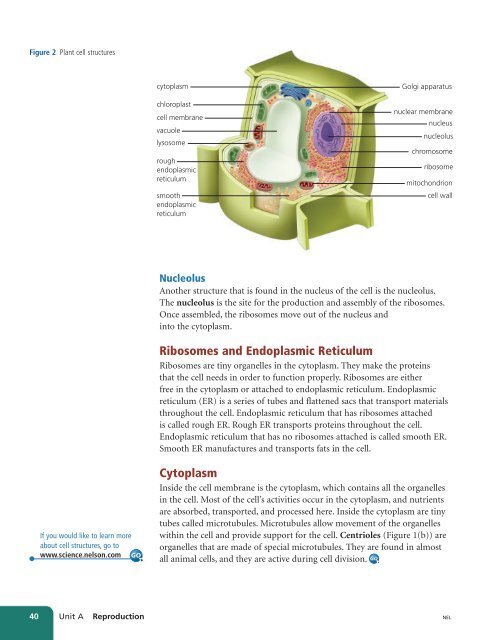Unit A Reproduction
Unit A Reproduction
Unit A Reproduction
Create successful ePaper yourself
Turn your PDF publications into a flip-book with our unique Google optimized e-Paper software.
Figure 2 Plant cell structures<br />
cytoplasm<br />
chloroplast<br />
cell membrane<br />
vacuole<br />
lysosome<br />
rough<br />
endoplasmic<br />
reticulum<br />
smooth<br />
endoplasmic<br />
reticulum<br />
Golgi apparatus<br />
nuclear membrane<br />
nucleus<br />
nucleolus<br />
chromosome<br />
ribosome<br />
mitochondrion<br />
cell wall<br />
Nucleolus<br />
Another structure that is found in the nucleus of the cell is the nucleolus.<br />
The nucleolus is the site for the production and assembly of the ribosomes.<br />
Once assembled, the ribosomes move out of the nucleus and<br />
into the cytoplasm.<br />
Ribosomes and Endoplasmic Reticulum<br />
Ribosomes are tiny organelles in the cytoplasm. They make the proteins<br />
that the cell needs in order to function properly. Ribosomes are either<br />
free in the cytoplasm or attached to endoplasmic reticulum. Endoplasmic<br />
reticulum (ER) is a series of tubes and flattened sacs that transport materials<br />
throughout the cell. Endoplasmic reticulum that has ribosomes attached<br />
is called rough ER. Rough ER transports proteins throughout the cell.<br />
Endoplasmic reticulum that has no ribosomes attached is called smooth ER.<br />
Smooth ER manufactures and transports fats in the cell.<br />
If you would like to learn more<br />
about cell structures, go to<br />
www.science.nelson.com GO<br />
Cytoplasm<br />
Inside the cell membrane is the cytoplasm, which contains all the organelles<br />
in the cell. Most of the cell’s activities occur in the cytoplasm, and nutrients<br />
are absorbed, transported, and processed here. Inside the cytoplasm are tiny<br />
tubes called microtubules. Microtubules allow movement of the organelles<br />
within the cell and provide support for the cell. Centrioles (Figure 1(b)) are<br />
organelles that are made of special microtubules. They are found in almost<br />
all animal cells, and they are active during cell division. GO<br />
40 <strong>Unit</strong> A <strong>Reproduction</strong><br />
NEL

















